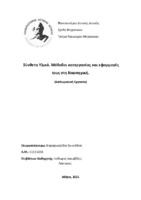| dc.contributor.advisor | Ιακωβίδης, Ισίδωρος | |
| dc.contributor.author | Καραχισαρίδης, Ευστάθιος | |
| dc.date.accessioned | 2021-09-13T07:36:48Z | |
| dc.date.available | 2021-09-13T07:36:48Z | |
| dc.date.issued | 2021-07 | |
| dc.identifier.uri | https://polynoe.lib.uniwa.gr/xmlui/handle/11400/1168 | |
| dc.identifier.uri | http://dx.doi.org/10.26265/polynoe-1019 | |
| dc.description | ΔΙΠΛΩΜΑΤΙΚΗ ΕΡΓΑΣΙΑ | el |
| dc.description.abstract | Η χρήση των σύνθετων υλικών έχει γνωρίσει μεγάλη ανάπτυξη σε ποικίλες τεχνολογικές εφαρμογές και τομείς, συμπεριλαμβανομένης και της ναυπηγικής, κυρίως για την κατασκευή μικρών σκαφών αλλά και επιμέρους εξαρτημάτων. Το χαρακτηριστικό που έστρεψε το ενδιαφέρον των σχεδιαστών προς αυτά οφείλεται στο συνδυασμό των πολύ καλών μηχανικών ιδιοτήτων με το χαμηλό βάρος αυτών των υλικών. Ένα επιπρόσθετο χαρακτηριστικό των σύνθετων υλικών είναι το γεγονός πως μπορεί να επιτευχθεί τοπική ενίσχυση με αποτέλεσμα να παρέχεται η δυνατότητα δημιουργίας βέλτιστων κατασκευών. Όσον αφορά το μέλλον των σύνθετων υλικών στην ναυτιλία αναμένεται να είναι πολλά υποσχόμενο λόγω των ιδιαιτέρων πλεονεκτημάτων που προσφέρουν, αλλά και της συνεχιζόμενης έρευνας που πραγματοποιείται στον τομέα ανάπτυξης νέων σύνθετων υλικών.
Στην παρούσα διπλωματική εργασία εξετάζονται τα σύνθετα υλικά καθώς και οι μέθοδοι κατεργασίας και εφαρμογής τους στη Ναυπηγική βιομηχανία.
Στο κεφάλαιο 1 παρουσιάζονται στοιχεία της θεωρίας των σύνθετων υλικών, διατυπώνονται οι απαιτούμενοι ορισμοί και περιγράφονται τα ιδιαίτερα χαρακτηριστικά καθώς και τα πλεονεκτήματα και μειονεκτήματα των σύνθετων υλικών που χρησιμοποιούνται στη ναυπηγική.
Στο κεφάλαιο 2 γίνεται εκτενέστερη αναφορά στις μηχανικές ιδιότητες των σύνθετων, σε μεθόδους κατεργασίας και σε τρόπους αστοχίας των υλικών αυτών. Επίσης παρουσιάζονται στοιχεία σχετικά με τους κανονισμούς που αφορούν τα σύνθετα υλικά και προέρχονται από τρεις από τους μεγαλύτερους νηογνώμονες του χώρου.
Στο κεφάλαιο 3 περιγράφεται η πειραματική διαδικασία κατασκευής δοκιμίων σύνθετων υλικών με ενισχυτικά υαλοϋφάσματα και εποξική ή πολυεστερική ρητίνη.
Στο κεφάλαιο 4 παρουσιάζονται τα αποτελέσματα των εργαστηριακών δοκιμών των ελέγχων των δοκιμίων που κατασκευάστηκαν.
Τέλος στο κεφάλαιο 5 συνοψίζονται τα συμπεράσματα της μελέτης και αναπτύσσονται ιδέες και προτάσεις για την μελλοντική συνέχιση της παρούσης εργασίας. | el |
| dc.format.extent | 165 | el |
| dc.language.iso | el | el |
| dc.publisher | Πανεπιστήμιο Δυτικής Αττικής | el |
| dc.rights | Αναφορά Δημιουργού - Μη Εμπορική Χρήση - Παρόμοια Διανομή 4.0 Διεθνές | * |
| dc.rights | Attribution-NonCommercial-NoDerivatives 4.0 Διεθνές | * |
| dc.rights.uri | http://creativecommons.org/licenses/by-nc-nd/4.0/ | * |
| dc.subject | Σύνθετο υλικό | el |
| dc.subject | Μητρική φάση | el |
| dc.subject | Ενίσχυση | el |
| dc.subject | Υαλοΰφασμα | el |
| dc.subject | Πυρήνας | el |
| dc.subject | Κριτήρια αστοχίας | el |
| dc.subject | Κανονισμοί νηογνώμονα | el |
| dc.title | Σύνθετα υλικά. Μέθοδοι κατεργασίας και εφαρμογές τους στη ναυπηγική | el |
| dc.title.alternative | Composite materials. Fabrication methods and marine applications. | el |
| dc.type | Διπλωματική εργασία | el |
| dc.contributor.committee | Mazarakos, Thomas | |
| dc.contributor.committee | Θεοχάρη, Σταματίνα | |
| dc.contributor.faculty | Σχολή Μηχανικών | el |
| dc.contributor.department | Τμήμα Ναυπηγών Μηχανικών | el |
| dc.description.abstracttranslated | The use of composite materials has experienced great development in a variety of technological applications and sectors, including shipbuilding, mainly for the construction of small boats and individual components. The feature that attracted the attention of designers is the combination of very good mechanical properties with the low weight of these materials. An additional feature of composite materials is the fact that local reinforcement can be achieved, thus enabling the creation of optimal structures. Regarding the future of composite materials in shipbuilding, it is expected to be very promising due to the special advantages they offer but also because of the ongoing research carried out in the field of development of new composite materials.
In the present dissertation, the composite materials as well as the methods of their processing and application in the shipbuilding industry are presented.
In chapter 1, elements of the theory of composite materials are presented together with the required definitions. In addition, the particular characteristics as well as the advantages and disadvantages of composite materials used in shipbuilding are discussed.
In chapter 2, a detailed description of the mechanical properties of the composites is carried out. Processing methods and failure modes of these materials are described. In addition, data concerning the composite materials are presented, according to the regulations issued from three of the largest shipbuilding classification societies.
In chapter 3, the experimental process of manufacturing composite specimens using glass fabric reinforcement and epoxy or polyester matrix is described.
In chapter 4, the results of the laboratory tests performed on the manufactured specimens are presented and discussed.
Finally ,in chapter 5, the conclusions of the study are summarized. Certain proposals and suggestions for a future research relative to the subject of the present work are presented. | el |


